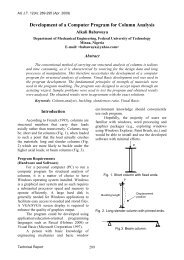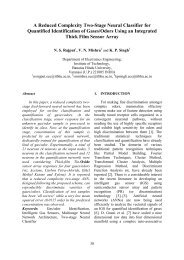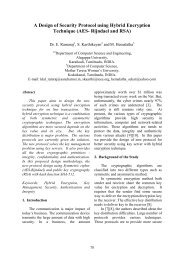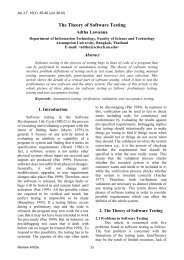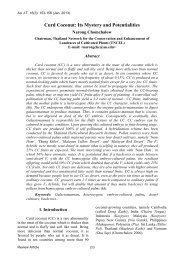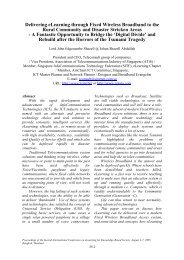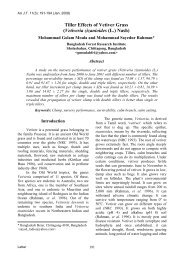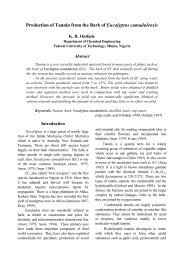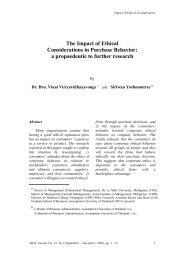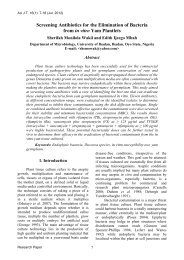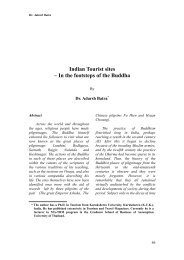Zeolites - Earliest Solid State Acids - AU Journal
Zeolites - Earliest Solid State Acids - AU Journal
Zeolites - Earliest Solid State Acids - AU Journal
You also want an ePaper? Increase the reach of your titles
YUMPU automatically turns print PDFs into web optimized ePapers that Google loves.
<strong>AU</strong> J.T. 11(1): 36-41 (Jul.2507)<br />
Mobil ZSM-5<br />
Fig. 9. Zeolite ZSM-5 MFI.<br />
ZSM-5, Tetrapropylammonium (TPA) is<br />
shown in Fig. 9. M stands for Mobil where this<br />
zeolite was discovered. It is a shape-selective<br />
catalyst with remarkable catalytic properties<br />
and high thermal stability. ZSM-5 has one set<br />
of pores zig-zag or sinusoidal. ZSM-5 has a<br />
very strong ability to promote hydrocarbon<br />
reactions. See picture in Fig. 10.<br />
ZSM-5 - A Size and Shape Selective Catalyst<br />
for Xylene Isomerization (Song et al 2004):<br />
Oil refinery fluid cat-cracking (FCC) units use<br />
ZSM-5 zeolite catalyst to increase the octane<br />
number of gasoline, increase the total LPG and<br />
also the olefin content of fractions - secondary<br />
"cracking" of gas oil.<br />
ZSM-5 Properties/Formation of p-Xylene:<br />
ZSM-5 zeolite has orthorhombic symmetry, as<br />
determined by model building, and single<br />
crystal or powder x-ray methods (Wikipedia<br />
2007, Mall-Net 2007). Aluminum/silicon ratio<br />
is one important feature. For syntheses pH <<br />
10, incorporated Al increases. The Si/Al ratio<br />
is between 5 and 20 (Song et al. 2004), due to<br />
structure stabilization by electrical interactions.<br />
Similarly for increased Si/Al ratio, cation<br />
density and electrostatic field strengths<br />
decrease, resulting in increased affinity of the<br />
zeolite surface for non-polar adsorbates. Silicarich<br />
zeolites "prefer" hydrocarbons over water.<br />
Thus the zeolite’s catalyst ability is<br />
determined by several parameters, such as<br />
presence of active sites (acidic, basic, cationic,<br />
etc.), spatial arrangement and size of the<br />
channels and pores, and the presence of<br />
extraneous compounds. Most active sites are<br />
located in intra-crystalline pores or cavities of<br />
molecular dimensions. This makes the<br />
compound shape-selective. In ZSM-5 the<br />
channel links are by intersections, and interior<br />
access to the molecule occurs by 8, 10, or 12<br />
peripheral oxygen atoms (ExxonMobil 2007).<br />
These properties make ZSM-5 an<br />
effective “molecular sieve” with characteristic<br />
absorption properties. For example consider the<br />
production of p-xylene from o-xylene. Friedel<br />
and Crafts catalysts produce isomerization,<br />
accompanied by a transalkylation, giving<br />
toluene and trimethylbenzene. A high<br />
isomerization to disproportion ratio is<br />
observed. This is because ZSM-5 pore size<br />
matches the xylene molecular diameter. The<br />
only reaction path is through a unimolecular<br />
1,2 methyl-shift mechanism. Thus ZSM-5 is a<br />
crucial catalyst for p- to o-xylene conversion.<br />
Characterization of Zeolite ZSM-5: The acid<br />
sites are characterized by using 31P solid-state<br />
NMR of the probe molecule<br />
trimethylphosphine oxide adsorbed onto<br />
zeolites, ZSM-5 in this case. The 31P nucleus<br />
is very sensitive and has a large chemical shift<br />
range and is therefore suitable to resolve<br />
different acid sites based on ‘proton donating<br />
ability’.<br />
Fig. 10. ZSM-5 nm view.<br />
Conclusion<br />
In conclusion impact of zeolites on the<br />
environment is mentioned. <strong>Zeolites</strong> or solid<br />
state acids keep the environment cleaner and<br />
Review Article 40



